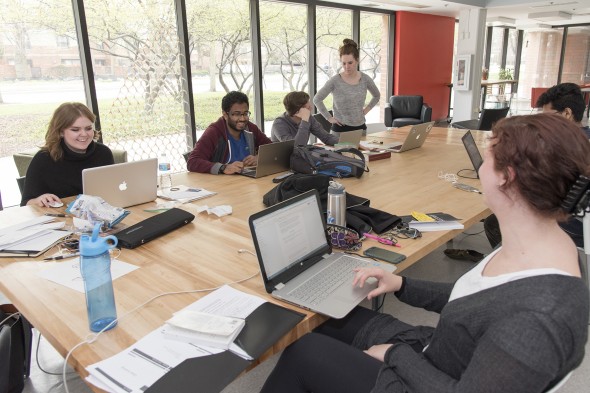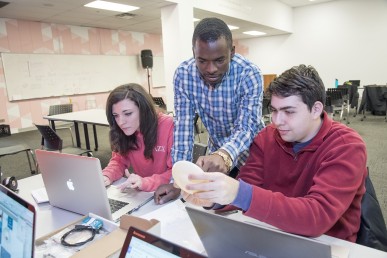East Meets West: Designing medical products

Students in the Interdisciplinary Product Development course work on their projects in the Innovation Center. “It’s really great to get that team-based type of environment right before going into the workforce,” says senior David Helm. Photo: Roberta Dupuis-Devlin
East Meets West is a collaboration of Provost Susan Poser and Vice Chancellor of Health Affairs Robert Barish
Daniel Helm still has a few weeks before he graduates, but he’s already had a taste of real-world workplace interactions.
Helm is among more than 30 students in bioengineering, business and industrial design who are working together — and learning from each other in the process — to solve complex medical problems in a two-semester course, Interdisciplinary Product Development.
“It’s really great to get that team-based type of environment right before going into the workforce because that’s what you’re going to be dealing with your entire life,” said Helm, a senior in industrial design.
During the course, which has been offered since 2002, students typically develop products to suit the needs of a corporate partner. This semester, however, the course partnered with Mark Rosenblatt, professor and head of ophthalmology, to address health care problems identified by faculty members.
“We want to create a culture of innovation within our department, think differently and take risks to do important things,” Rosenblatt said. “I’ve been tremendously impressed with the Innovation Center and what’s happening there.”
Collaborative teams
Students gather in the Innovation Center to tackle their product development projects under the direction of three professors: Stephen Melamed, industrial design, Miiri Kotche, bioengineering, and Jelena Spanjol, business. Students collaborate to develop an idea for a product, create and test it, and formulate a marketing plan.

Students in bioengineering, industrial design and marketing are developing products to address health care problems
identified by UIC faculty members in ophthalmology. Next year, medical students will join the two-semester course. Photo: Roberta Dupuis-Devlin
They are tackling five complex problems on topics such as helping patients with macular degeneration see better, relieving dryness related to computer vision syndrome, and screening babies for an eye disease in a more cost-effective way, among other projects.
Rosenblatt is impressed with the students’ work so far.
“It’s a wonderful group of people working in concert, with multidisciplinary understandings of the problems,” Rosenblatt said. “They’re making great progress and have a lot of passion and see how they can actually help people. Things they had only imagined are really starting to happen.”
Rich Hickey’s group is working on developing a more effective way to administer eye drops.
“We thought it was an inspiring problem,” said Hickey, a senior in bioengineering.
His group includes two industrial designers, two bioengineers and two marketers.
“We have a good dynamic,” he said. “We’ve learned how to distribute the work amongst the different disciplines. I’ve learned a lot about how to design something and what considerations you need to sell it, and that’s something as engineers that we don’t talk a lot about when solving problems.”
Louis Panozzo, a senior in marketing, is working with his group on developing a device that would help physicians more quickly diagnose conditions related to corneal sensitivity, such as dry eye syndrome.
“Working with other disciplines really helps the project come to fruition, where everyone is working toward the same goal,” he said.
The course instills a sense of confidence in its students, said Kotche, who has taught the class for four years..
“There are only one or two people from each discipline on a team, so you can’t hide behind someone else,” said Kotche, clinical associate professor of bioengineering.
The students’ work could enhance existing patent applications or potentially generate new intellectual property, Melamed said. In past years, students’ work has been further developed and even commercialized by corporate sponsors.
“Every year we are stretching the boundaries of the course,” Spanjol said. “These are very high-level problems. I’m incredibly impressed by the technical capabilities of the students individually, but also how they are able to come together and really leverage each other.”
Faculty working together
Melamed has taught the course since its inception in 2002, and is one of the three founding faculty members of the IPD Program.
“We thought it was important to expose our students to best practices and give them the experience they would have in the working world while still in the academic institution,” said Melamed, clinical professor in the School of Design.
Collaboration among faculty members from three disciplines has also been a tremendous learning opportunity, Melamed said.
“It’s a lot more work than teaching your own class but the rewards are immense,” he said. “It has really broadened my perspective on my own discipline.”
Course materials are jointly developed and delivered by the faculty team, said Spanjol, who has taught the class for five years.
“We get to model for students how to work across functional boundaries,” said Spanjol, associate professor of marketing.
The class will expand next year to include second-year medical students from the innovation medicine program.
“The addition of medical students will be fantastic and serve to integrate health care provider experiences into the innovation development process,” Spanjol said. “It’s very unique to have this many different perspectives onto the same problem and project.”
Categories
Topics
bioengineering, collaboration, Innovation Center, Interdisciplinary Product Development, IPD
